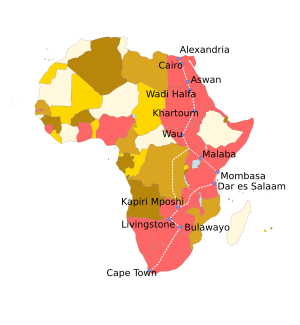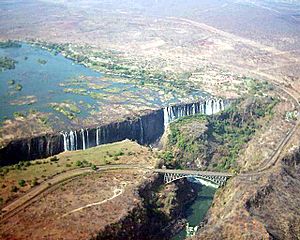Cape to Cairo Railway facts for kids
Quick facts for kids Cairo–Cape railway |
|
|---|---|
| Overview | |
| Status | Only a few stretches in operation 5,625 kilometres (3,495 mi) |
| Termini | Cape Town, South Africa Port Said, Egypt |
| Service | |
| Type | High-speed rail Heavy rail |
| Technical | |
| Line length | 10,489 km (6,518 mi) |
| Track gauge | 1,435 mm (4 ft 8 1⁄2 in) |
| Electrification | 25 kV 50/60 Hz AC |
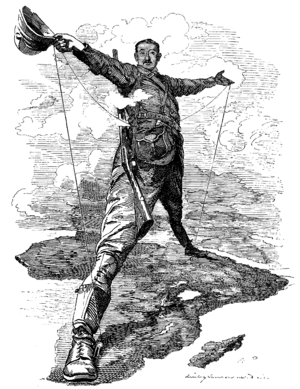
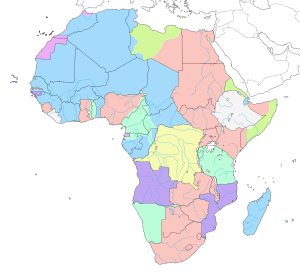
This map shows the chain of colonies from the Cape to Cairo that the railway would cross. After 1916, Tanganyika Territory was added, filling in the missing part.
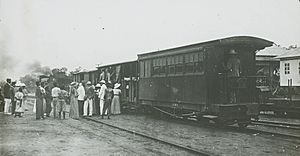
The Cape to Cairo Railway was a huge railway project that was never fully finished. It aimed to build a train line all the way across Africa, from south to north. The idea was to connect Cape Town in South Africa to Port Said in Egypt. If completed, it would have been the biggest and most important railway in Africa.
Even though some parts were built, the full railway was never completed. Many of the finished sections are not used anymore. This is often because of wars and a lack of care in the countries that used to be colonies.
The plan for this railway started in the late 1800s. This was a time when European countries ruled many parts of Africa. The main person behind the idea was Cecil Rhodes. He wanted to connect all the British-controlled lands in Africa with a continuous railway line. This would stretch from Cape Town to Cairo, Egypt.
Contents
Building the Dream Railway
The first idea for a "Cape to Cairo" railway came from Edwin Arnold in 1874. He was the editor of The Daily Telegraph newspaper. His plan involved using both trains and river boats for parts of the journey.
Cecil Rhodes, a powerful businessman and politician, was key to this project. He wanted to make sure Britain controlled a continuous "red line" of land from the very south to the very north of Africa. A railway was a vital part of his plan. It would help Britain manage its lands, move soldiers quickly if there was trouble, encourage people to settle, and make it easier to trade goods. Building such a long railway across Africa was a massive challenge for the technology of that time.
Other European countries also had their own plans for railways in Africa. France, for example, wanted to link its colonies from west to east. This led to a tense situation in 1898 called the Fashoda Incident. British and French forces met in South Sudan, and the French eventually backed down.
Portugal also dreamed of connecting its colonies in Angola (west) and Mozambique (east) with a railway. They even drew a "Pink Map" to show their claims across Africa.
In South Africa, there was fighting between the British and the Boers (Dutch settlers). After the Second Boer War ended in 1902, the British gained more control, which helped their railway plans.
Egypt already had a railway system that connected cities like Port Said, Alexandria, and Cairo as early as 1854. This line now reaches as far south as Aswan. In Egypt, the railway uses a standard track width (called a gauge) of 1435mm. After a boat trip across the River Nile, the railway continues into Sudan. This part of the system was started in 1897 by Lord Kitchener. He built it to move supplies during a war against a local uprising.
Today, the railway lines in South Sudan are mostly not working due to conflicts. Also, much of Sudan's railway network is in poor condition. However, some services have started again, especially around Khartoum, with help from China.
Why the Railway Was Never Finished
Building the Cape to Cairo Railway faced many challenges. There were difficult landscapes and climates. Also, other European powers like France, Portugal, and Germany had their own plans for Africa. In 1891, Germany took control of German East Africa (modern-day Tanzania). This land blocked the direct path for the British railway.
However, during World War I (1914-1918), British, African, and Indian soldiers took control of Tanganyika Territory from the Germans. After the war, Britain continued to rule this area. This meant that Britain now had a continuous line of colonies from the Cape to Cairo.
The southern part of the railway was mostly completed before World War I. This section used a track width called the Cape gauge (1067mm). Construction began in Cape Town and went through Kimberley and parts of Botswana to Bulawayo in Zimbabwe. The famous Victoria Falls Bridge was finished in 1905.
Even though the British Empire had the power to finish the railway, money problems got in the way. The Great Depression in the 1930s made it hard to find funds. After World War II, many African countries gained their independence. This changed the reasons for building the railway and made the project much harder to complete. So, the dream of a full Cape to Cairo Railway slowly faded.
Parts of the Railway Still Running
Today, about 5,625 kilometers (3,495 miles) of the total 10,489 kilometers (6,518 miles) of the planned railway are still in use. Here are some of the main sections that are still operational:
- South-western section: From Cape Town in South Africa, it passes through Kimberley and Mahikeng. It then goes into Botswana through Gaborone and Francistown, ending in Bulawayo in Zimbabwe.
- South-eastern section: This part starts from Port Elizabeth in South Africa. It goes through Bloemfontein, Johannesburg, Pretoria, and Musina, also connecting to Bulawayo in Zimbabwe.
- South-central section: From Bulawayo, it crosses the Victoria Falls Bridge into Zambia, going through Livingstone, Lusaka, and Ndola. It then enters the Democratic Republic of the Congo (Congo-Kinshasa), connecting cities like Lubumbashi and Kindu.
- Central stretch: This section connects Kampala to other towns in Uganda like Tororo and Gulu.
- There's a missing link from Gulu in Uganda to Juba and Wau in South Sudan.
- The line from Wau to Babanusa in Sudan is currently not working due to local conflicts.
- North-upper Nile stretch: This connects Babanusa to Sennar, Khartoum, and Wadi Halfa in Sudan.
- There is a gap between Wadi Halfa in Sudan and Aswan in Egypt.
- North-lower Nile stretch: This connects Aswan to Luxor, Cairo, and Benha in Egypt.
- Other Egyptian sections: From Benha, lines connect to Alexandria, Damietta, and Port Said in Egypt.
Connecting to Other Railways
The Cape to Cairo Railway was meant to be a major link, but other railway systems also grew in Africa.
Uganda Railway
East Africa has its own network of narrower railways (1000mm gauge). These lines were built by the British and Germans, starting from ports on the Indian Ocean and moving inland. Eventually, these networks connected. Today, you can travel by train from Kampala, Uganda, to coastal cities like Mombasa in Kenya and Dar es Salaam in Tanzania.
TAZARA Link
From Dar es Salaam, a 1,860 km (1,156 mi) railway called TAZARA (Tanzania-Zambia-Railway) was built between 1970 and 1975. China helped build and pay for this project. It connected Kapiri Mposhi in Zambia to the port of Dar es Salaam. This was important for Zambia, a landlocked country, to export its minerals without relying on ports in South Africa. The TAZARA line uses the same 1067mm gauge as the southern part of the Cape to Cairo railway.
Benguela-Katanga Link
In the city of Tenke in the Democratic Republic of the Congo, the Cape-Cairo Railway connects with the Benguela railway. This line links to the port of Lobito in Angola, on the Atlantic coast.
Kidatu Connection
In 1998, a special transfer point was built at Kidatu in southern Tanzania. This allowed goods to be moved between the narrower Central Line (1000mm gauge) and the wider TAZARA line (1067mm gauge).
Railways in Mozambique, Zimbabwe, and South Africa
The railway system in the southern part of Africa is also connected to the railway networks in Mozambique, Zimbabwe, and South Africa. These connections reach important ports like Maputo and Beira.
The Road Version
Besides the railway, there was also a plan for a "Cape to Cairo Road." In 1924, an expedition called the Court Treatt expedition successfully traveled from Cape to Cairo using two cars! The road plan was later updated into the Cairo–Cape Town Highway, and large parts of it are now paved and usable.
In Stories
The idea of the Cape to Cairo Railway has even appeared in books. In John Crowley's science fiction story Great Work of Time, the British Empire survives for much longer, and the Cape to Cairo Railway is completed. The main character in the story travels comfortably along the entire route.
See also
- Cape to Cairo
- Northern Africa Railroad Development
- Scramble for Africa
- Fashoda Incident
- East African Railway Master Plan
- Lamu Port and Lamu-Southern Sudan-Ethiopia Transport Corridor – 2012
- Kunming–Singapore railway


